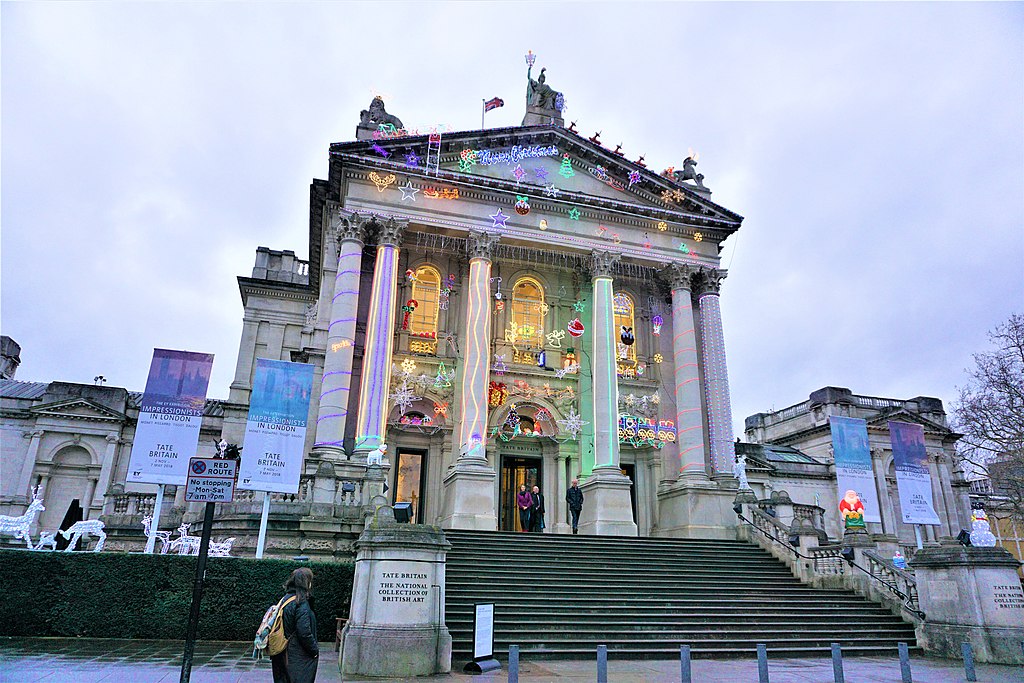
Tate Britain is part of the Tate network of galleries in England, with Tate Modern, Tate Liverpool, and Tate St Ives. Tate Britain is the oldest gallery in the network, having opened in 1897.
Tate Britain houses a significant and extensive collection of the art of British art from 1500 to the present day.
It also has substantial holdings of the works of J. M. W. Turner, who bequeathed all his collection to the nation.
A Virtual Tour of Tate Britain
- “Christ in the House of His Parents” by John Everett Millais
- “Ophelia” by John Everett Millais
- “The Lady of Shalott” by John William Waterhouse
- “Youth on the Prow, and Pleasure at the Helm” by William Etty
- “Claude Monet Painting by the Edge of a Wood” by John Singer Sargent
- “Love Locked Out” by Anna Lea Merritt
- “King Cophetua and the Beggar Maid” by Edward Burne-Jones
- “Snow Storm: Steam-Boat off a Harbour’s Mouth” by J. M. W. Turner
Support Joy of Museums
by SPONSORING one of our Pages for $5
- “Snow Storm: Hannibal and his Army Crossing the Alps” by J. M. W. Turner
- “The Gallery of HMS Calcutta (Portsmouth)” by James Tissot
- “Portsmouth Dockyard” by James Tissot
- “Self-Portrait” by J. M. W. Turner
- “Almina Daughter of Asher Wertheimer” by John Singer Sargent
- “Past and Present” by Augustus Egg
- “The Death of Major Peirson, 6 January 1781″ by John Singleton Copley
- “Nocturne: Blue and Silver – Chelsea” by James Abbott McNeill Whistler
- “Amor and Psyche” by Alphonse Legros
- “The Lament for Icarus” by Herbert James Draper
- “Portrait of Miss Lloyd” by James Tissot
- Masterpieces of Tate Britain
- “The Decline of the Carthaginian Empire” by J. M. W. Turner
- “Venice, the Bridge of Sighs” by J. M. W. Turner
- “Consulting the Oracle” by John William Waterhouse
- “The Beloved” by Dante Gabriel Rossetti
- “Carnation, Lily, Lily, Rose” by John Singer Sargent
- “Paolo and Francesca da Rimini” by Dante Gabriel Rossetti
- “The Eve of St Agnes” by Arthur Hughes
- “The Last Voyage of Henry Hudson” by John Collier
- “The North-West Passage” by John Everett Millais
Tate Britain
- Name: Tate Britain
- Previously: National Gallery of British Art (1897-1932); Tate Gallery (1932-2000)
- City: London
- Country: United Kingdom
- Established: 1897
- Type: Art Museum
- Locations: Millbank, London, United Kingdom
Highlights Tour of Tate Britain
“Christ in the House of His Parents” by John Everett Millais
“Christ in the House of His Parents” by John Everett Milla depicts the Holy Family in Joseph’s carpentry workshop. The painting centers on the young Jesus, who has cut his hand while assisting Joseph in his workshop.
The composition has a plethora of symbolism representing the theological aspects of this religious subject. The most interesting aspect of this painting was how controversial it was when it was first exhibited.
It received many negative reviews because of its realistic depiction of a carpentry workshop, especially the dirt and wood shavings on the floor.

“Ophelia” by John Everett Millais
“Ophelia” by John Everett Millais depicts Ophelia, a character in William Shakespeare’s play Hamlet; the scene is described in a speech by Queen Gertrude.
Ophelia is singing while floating in a river in Denmark before she drowns. This Pre-Raphaelite work was not highly regarded when first exhibited at the Royal Academy, but has since come to be admired and influential for its beauty and its detailed and accurate depiction.

“The Lady of Shalott” by John William Waterhouse
The Lady of Shalott” by John William Waterhouse, portrays the ending of Alfred, Lord Tennyson’s 1832 poem of the same name.
The scene shows the plight of a young woman from Arthurian legend, who yearned with unrequited love for the knight Sir Lancelot but was isolated under a curse in a tower near King Arthur’s Camelot.
The Lady of Shalott was forbidden to look directly at the outside world. She was doomed to view the world through a mirror and weave what she saw into a tapestry. Her despair intensified when she saw loving couples in the far distance.
One day she saw Sir Lancelot passing on his way in the reflection of her mirror, and she was overcome with desire and dared to look out at Camelot, bringing about the curse.
The lady decided to face her destiny and escaped by boat, to sail to Camelot and her inevitable death.
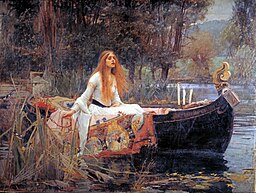
“Youth on the Prow, and Pleasure at the Helm” by William Etty
“Youth on the Prow, and Pleasure at the Helm” by William Etty was inspired by a metaphor in Thomas Gray’s poem “The Bard.” In the poem, the rule of a monarch was compared to a gilded ship whose occupants are unaware of an approaching storm.
Etty chose to illustrate the metaphor by depicting a golden boat filled with and surrounded by nude and near-nude figures.
The nude figure above the ship, representing Zephyrus, the Greek mythological personification of the west wind, blowing on the sails.
Another nude representing Pleasure, lies on a large bouquet, loosely holding the helm of the boat and allowing Zephyr’s breeze to dictate its course.
The naked figures were intended to express the themes of sexual appetites entrapping innocent youth, and the sexual power women hold over men.

“Claude Monet Painting by the Edge of a Wood” by John Singer Sargent
Claude Monet Painting by the Edge of a Wood” by John Singer Sargent shows the famous impressionist master Claude Monet at Giverny together with Alice Hoschedé, whom Monet had befriended and who was to become his second wife.
Monet is sitting at an easel painting a landscape outdoors, doing what he advocated, painting directly from nature.
In the 1880s, Sargent attended the Impressionist exhibitions, and he began to paint outdoors in the Plein-air manner after visiting Claude Monet at his home in the village of Giverny. This painting reflects Claude Monet’s influence on Sargent, who purchased four Monet works for his collection.
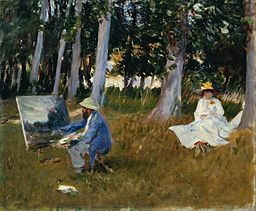
“Love Locked Out” by Anna Lea Merritt
Love Locked Out” by Anna Lea Merritt is the artist’s best-known work, and in memory of her late husband, who died in 1877, just three months after their wedding.
Cupid, the mythology god of love, is shown here trying to force open the door of a mausoleum. Merritt feared the subject of her painting would be misinterpreted.
She wrote in her memoir: “I feared people liked it as a symbol of forbidden love, while my Love was waiting for the door of death to open and the reunion of the lonely pair.” The depiction of the male nude by a female artist was controversial in late nineteenth-century London.
Merrit received favorable reviews by choosing to paint a child and not an adult. Children, she believed, were less conscious of nudity.

“Almina Daughter of Asher Wertheimer” by John Singer Sargent
“Portrait of Almina Daughter of Asher Wertheimer” by John Singer Sargent was the last in the series of Sargent’s portraits of the Wertheimer family.
The Wertheimer portraits are a series of twelve portrait paintings made by John Singer Sargent of and for the British art dealer Asher Wertheimer (1843-1918) and his family. The series was Sargent’s most significant private commission.
Almina was Asher Wertheimer’s fifth daughter. She is shown in an oriental costume of a white Persian dress and a turban entwined with pearls.
The white and green over-jacket was a studio prop, as was the musical instrument. Paintings of European women cast as alluring ‘orientals’ were fashionable at the turn of the twentieth century. Almina (1886-1928), married Antonio Pandelli Fachiri (1886-1928/9) in 1915.

Support Joy of Museums
by SPONSORING one of our Pages for $5
“Nocturne: Blue and Silver – Chelsea” by James Abbott McNeill Whistler
“Nocturne: Blue and Silver – Chelsea” by James Abbott McNeill Whistler is the artist’s earliest of the London Nocturnes by James McNeill Whistler.
This painting is the first of thirty-two nighttime landscapes that Whistler began calling nocturnes. All the nocturnes were painted with extremely fluid paint that allowed Whistler to build thin layers of luminous color.
The fluid mixture was so thin that the wet canvas had to be painted flat, so the paint would not run.

“Amor and Psyche” by Alphonse Legros
“Amor and Psyche” by Alphonse Legros is a depiction of Cupid as he approaches the princess to wake her by touching her with his arrow. Venus was jealous of Psyche’s beauty, and she sent her son Cupid to work her revenge.
Cupid is sent to shoot Psyche with an arrow so that she may fall in love with something hideous.
He instead scratches himself with his dart, which makes any living thing fall in love with the first thing it sees. Consequently, he falls deeply in love with Psyche.

“The Lament for Icarus” by Herbert James Draper
“The Lament for Icarus” by Herbert James Draper depicts the dead Icarus, surrounded by lamenting nymphs.
The wings of Icarus are based on the bird-of-paradise pattern and surprising, Icarus’s wings appear fully intact, contrary to the myth where the wax melted and Icarus fell flapping his bare arms.
This Pre-Raphaelite inspired image of a beautiful winged creature was used to create a symbolic, romantic, and heroic appearance. The tanned skin of Icarus symbolizes his close approach to the Sun before falling.
The rays of the setting sun on distant cliffs emphasize the transience of time.

“The Decline of the Carthaginian Empire” by J. M. W. Turner
“The Decline of the Carthaginian Empire” by J. M. W. Turner depicts the final days of the capital city of the ancient Carthaginian civilization.
Carthage was once the most important trading hub of the Ancient Mediterranean and one of the most affluent cities of the Ancient World.
However, as Roman power and ambition increased, the Romans fought three wars against Carthage. The Roman Republic eventually destroyed the ancient city in the Third Punic War in 146 BC.
As the Carthaginian Empire fell, another superpower in the form of the Roman Empire rose.

“Venice, the Bridge of Sighs” by J. M. W. Turner
“Venice, the Bridge of Sighs” by J. M. W. Turner depicts several famous landmarks in Venice. The enclosed “Bridge of Sighs” connects the Doge’s Palace on the left with the prisons of the Palazzo dei Prigioni to the right.
The Bridge of Sighs is an enclosed arch bridge made of white limestone, which was built in 1600.
The Bridge of Sighs crossed the Rio di Palazzo waterway and has windows with stone bars. It connects the New Prison to the interrogation rooms in the Doge’s Palace.

“Consulting the Oracle” by John William Waterhouse
“Consulting the Oracle” by John William Waterhouse depicts a group of seven young girls, sitting in a semicircle around a lamplit shrine. They are waiting in anticipation for the priestess to interpret the words of the Teraph.
The priestess motions for silence as she bends forward to catch the mysterious utterances.
The Teraph was a human head, cured with spices, which was fixed against the wall, with lamps being lit before it. A teraph was an idol or image reverenced by the ancient Hebrews and kindred peoples, apparently as a household god.
Primitive religious rites were performed in the presence of Teraph. Also, the imagination of diviners was inspired to hear a low voice predicting future events. The painting’s setting is imaginary but has exotic, middle-eastern motifs.

“Saint Eulalia” by John William Waterhouse
“Saint Eulalia” by John William Waterhouse depicts the aftermath of the death of Eulalia of Mérida. According to her legend, the snow was sent by God as a shroud to cover her nakedness.
The white dove, flying upwards above the heads of the crowd of mourners, is indicative of Eulalia’s soul flying up to Heaven. Her body is at the foot of a cross. The Roman guards restrain all the mourners to the background.
This composition is one of Waterhouse’s most daring artworks. The body is dramatically foreshortened, and the snow contrasts with 12-year’s exposed flesh.
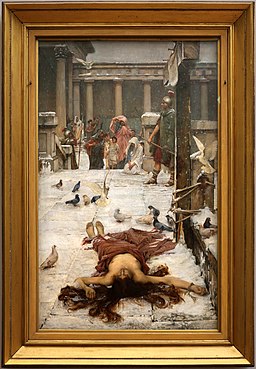
“The Beloved” by Dante Gabriel Rossetti
“The Beloved” by Dante Gabriel Rossetti was inspired by the biblical “Song of Solomon.” It tells the story of a young woman preparing to marry.
The bride is depicted moving back her veil, while her eyes are fixed directly on the viewer. She is attended by four bridesmaids and an African page child, holding roses.
The bridal party all contrasts strikingly with the red hair and pale skin of the bride. They have varying shades of brunette hair and darker skin tones. This color contrast was carefully painted as a frame to the bride’s features.

Support Joy of Museums
by SPONSORING one of our Pages for $5
“Carnation, Lily, Lily, Rose” by John Singer Sargent
“Carnation, Lily, Lily, Rose” by John Singer Sargent depicts two small children who are lighting Japanese lanterns with tapers on a twilit summer evening.
The two young girls dressed in white are in a garden dominated by green foliage, full of pink roses, with a selection of yellow carnations and tall white lilies above them.
The viewer’s perspective is set at an adult’s eye level, looking down on the children and the lanterns.

“Paolo and Francesca da Rimini” by Dante Gabriel Rossetti
“Paolo and Francesca da Rimini” by Dante Gabriel Rossetti tells the tragic story of the lovers, Paolo and Francesca.
The story is from Dante’s Inferno and was a popular subject with artists and sculptors beginning in the late 18th Century. Rossetti’s composition is divided into three parts.
Rossetti’s real name was Charles Gabriel Dante Rossetti, but his admiration for the great Florentine poet led him to change it to Dante Gabriel Rossetti.
Throughout his life, Rossetti was fascinated by stories of tragic lovers and illicit love. The subject of this painting is taken from Dante Alighieri’s most famous work, Inferno, Canto V.
This painting is a small watercolor triptych executed in the medievalist style of this period in Rossetti’s art.

Art Movements
An art movement is an art style with a common philosophy followed by a group of artists during a period. There are many overlaps between various periods and movements, especially as movements that started in one country slowly crossed the world.
Some of the major Art Periods and Movements covered by The National Gallery and Tate Britain include:
-
- Italian Renaissance – 1300 – 1700
- Early Netherlandish painting – 1400 – 1500
- Mannerism – 1520 – 1600
- Baroque – 1600 – 1730
- Rococo – 1720 – 1780, began in France
- Neoclassicism – 1750 – 1830
- Romanticism -1790 – 1880
- Realism – 1830 – 1870, began in France
- Pre-Raphaelite Brotherhood – 1848 – 1854, England
- Modern art – 1860 – 1945
- Impressionism – 1860 – 1890
- Symbolism – 1880 – 1910
- Pointillism 1879, France
- Art Nouveau – 1890 – 1914, France
- Vienna Secession – 1897, Austria
- Fauvism – 1904 – 1909, France
- Cubism – 1907 – 1914, France
- Art Deco – 1909 – 1939, France
- Dada – 1916 – 1930, Switzerland
- Bauhaus – 1919 – 1933, Germany
- Surrealism – the 1920s, France
- Abstract Expressionism – 1940s, United States
- Contemporary art – 1946–present
- Pop Art mid-1950s, United Kingdom/United States
- Minimalism – 1960 –
- Graffiti 1960s-
- Postmodern art 1970 – present
- Digital art 1990 – present
Explore London’s Museums and Heritage Sites
- The British Museum
- The National Gallery, London
- Tate Britain
- The Wallace Collection
- The Victoria and Albert Museum
- Queen’s Gallery, Buckingham Palace
- Courtauld Gallery
- Tate Modern, London
- Science Museum, London
- National Portrait Gallery, London
- Natural History Museum
- Charles Dickens Museum
- Hampton Court Palace
- Sherlock Holmes Museum
- British Library
- Imperial War Museum
Map of Tate Britain
Tate Britain: A walk-through of 500 years of British Art
Tate Britain Highlights | Meet 500 Years of British Art
~~~
“Great events make me quiet and calm; it is only trifles that irritate my nerves.”
– Queen Victoria
~~~
Photo Credit: JOM; John Everett Millais [Public domain]; John Everett Millais [CC BY 3.0 (https://creativecommons.org/licenses/by/3.0)]; John William Waterhouse [Public domain]; William Etty [Public domain]; The original uploader was Sparkit at English Wikipedia. [Public domain], via Wikimedia Commons;
Popular this Week

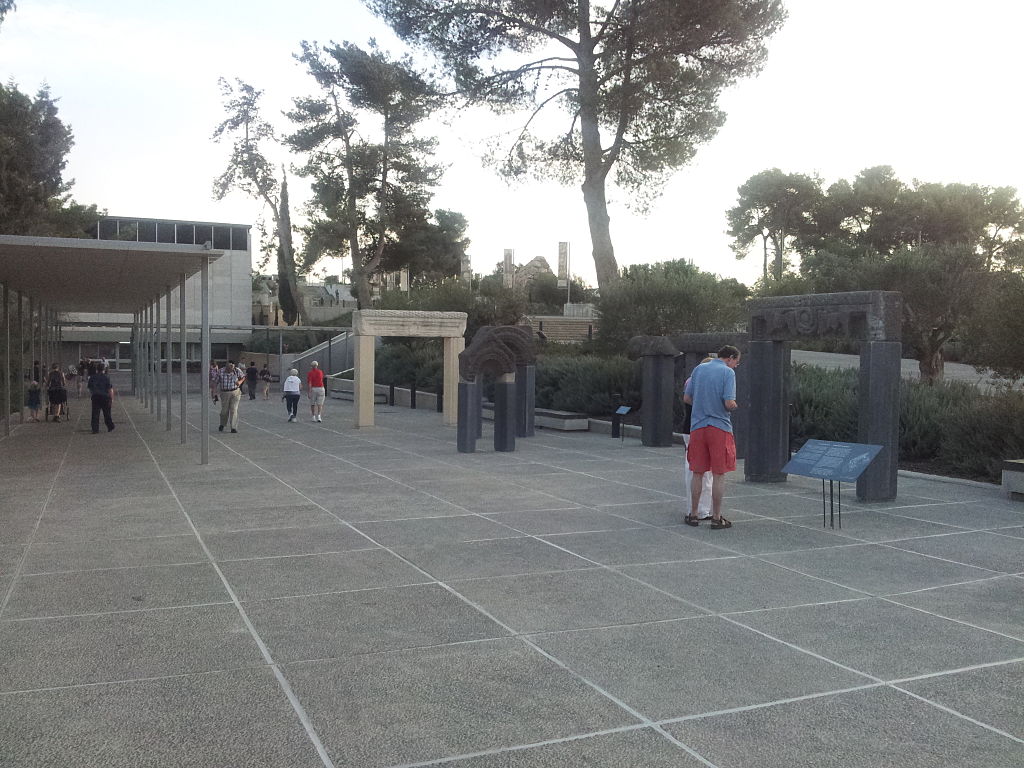




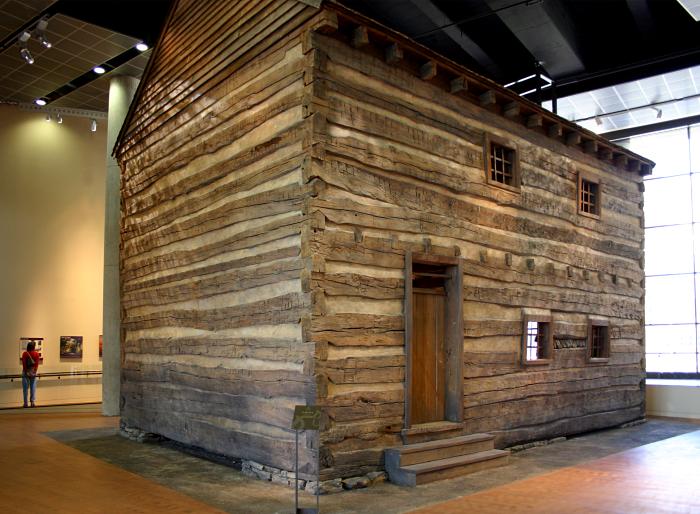

 Sponsor your Favorite Page
Sponsor your Favorite Page SEARCH Search for: Search Follow UsJoin – The JOM Membership Program
Sponsor a Masterpiece with YOUR NAME CHOICE for $5
Share this:
- Tweet
